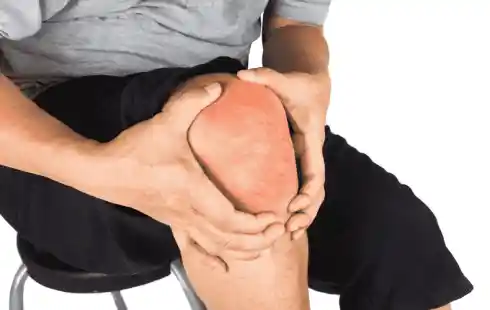
Pantone's Color of the Year an Endless Neutral Loop
Section: Fashion
 Knee pain is a common complaint that affects millions of people worldwide, ranging from athletes and active individuals to sedentary office workers and older adults. While often dismissed as a natural consequence of aging or physical activity, knee pain can stem from a multitude of underlying factors, each requiring a tailored approach to diagnosis and treatment. From overuse injuries to degenerative conditions, here's a comprehensive exploration of the diverse reasons why individuals may experience knee pain.
Knee pain is a common complaint that affects millions of people worldwide, ranging from athletes and active individuals to sedentary office workers and older adults. While often dismissed as a natural consequence of aging or physical activity, knee pain can stem from a multitude of underlying factors, each requiring a tailored approach to diagnosis and treatment. From overuse injuries to degenerative conditions, here's a comprehensive exploration of the diverse reasons why individuals may experience knee pain.
1. Overuse and Repetitive Strain:
One of the most common causes of knee pain is overuse and repetitive strain, particularly among athletes and individuals engaged in activities that place repetitive stress on the knees, such as running, cycling, or jumping. Continuous stress on the knee joint and surrounding structures can lead to inflammation, strain, and eventual injury to ligaments, tendons, and cartilage, resulting in pain, swelling, and reduced range of motion.
2. Ligament Injuries:
Ligament injuries, such as anterior cruciate ligament (ACL) tears, medial collateral ligament (MCL) sprains, and posterior cruciate ligament (PCL) injuries, are frequent causes of knee pain, often resulting from sudden twists, falls, or direct impact during sports or accidents. These injuries can cause significant pain, instability, and functional impairment, necessitating prompt medical evaluation and appropriate management, which may include physical therapy or surgical intervention.
3. Meniscal Tears:
The menisci are C-shaped pieces of cartilage that act as shock absorbers within the knee joint, cushioning and stabilizing the bones during movement. Tears in the meniscus can occur due to sudden twisting motions, degenerative changes associated with aging, or repetitive stress over time. Meniscal tears commonly cause localized pain, swelling, and locking or catching sensations in the knee, often requiring conservative treatments such as rest, ice, physical therapy, or in some cases, surgical repair.
4. Osteoarthritis:
Osteoarthritis, a degenerative joint disease characterized by the breakdown of cartilage and bone within the knee joint, is a leading cause of knee pain, particularly among older adults. Over time, the gradual loss of cartilage leads to joint inflammation, pain, stiffness, and reduced mobility. While osteoarthritis cannot be cured, various treatment options, including medication, physical therapy, lifestyle modifications, and in severe cases, joint replacement surgery, can help manage symptoms and improve quality of life.
5. Patellar Tendinitis (Jumper's Knee):
Patellar tendinitis, also known as jumper's knee, is an overuse injury characterized by inflammation and microtears in the patellar tendon, which connects the kneecap (patella) to the shinbone (tibia). This condition commonly affects athletes involved in jumping sports, such as basketball and volleyball, as well as individuals who engage in activities that involve repetitive bending and straightening of the knee. Treatment typically involves rest, ice, physical therapy, and modifying activities to alleviate strain on the tendon.
6. Bursitis:
Bursae are small fluid-filled sacs located around the knee joint that serve to reduce friction between bones, tendons, and muscles. Bursitis occurs when these sacs become inflamed due to repetitive pressure, trauma, or infection, resulting in localized pain, swelling, and tenderness. Treatment often involves rest, ice, anti-inflammatory medication, and, in severe cases, aspiration of fluid from the bursa or corticosteroid injections to alleviate inflammation.
7. Other Contributing Factors:
In addition to the aforementioned causes, several other factors can contribute to knee pain, including obesity, poor biomechanics, muscle imbalances, improper footwear, and underlying medical conditions such as rheumatoid arthritis, gout, or infections. Identifying and addressing these contributing factors is essential for effective management and prevention of recurrent knee pain.
Knee pain is a multifaceted condition with a myriad of potential causes, ranging from overuse injuries and ligament tears to degenerative joint diseases and inflammatory conditions. Understanding the underlying factors contributing to knee pain is crucial for accurate diagnosis and targeted treatment interventions tailored to individual needs. By addressing the root causes of knee pain and implementing appropriate therapeutic strategies, individuals can alleviate discomfort, improve function, and maintain long-term joint health and mobility. If you're experiencing persistent or severe knee pain, consulting a healthcare professional for evaluation and personalized treatment recommendations is essential for optimal outcomes and quality of life.

Section: Fashion

Section: News

Section: Fashion

Section: Arts

Section: Politics

Section: Health Insurance

Section: News

Section: News

Section: News

Section: Arts
Both private Health Insurance in Germany and public insurance, is often complicated to navigate, not to mention expensive. As an expat, you are required to navigate this landscape within weeks of arriving, so check our FAQ on PKV. For our guide on resources and access to agents who can give you a competitive quote, try our PKV Cost comparison tool.
Germany is famous for its medical expertise and extensive number of hospitals and clinics. See this comprehensive directory of hospitals and clinics across the country, complete with links to their websites, addresses, contact info, and specializations/services.
Join us for an enchanting Christmas adventure at the Münchner Marionettentheater! Experience the marionette play 'Der verschwundene Wunschzettel' by Siegfried Böhmke, featuring our beloved Kasperl Larifari and his little friend Stupsi. As Christmas approaches, both Kasperl and Stupsi have prepared...



No comments yet. Be the first to comment!